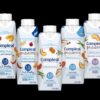A recent survey found that a staggering 82% of moms are anxious about the influence of digital devices on their children’s cognitive health. Yet, many are unaware that nutrition can play a pivotal role in addressing these concerns. To shed light on this vital topic, we spoke with Dr. Tanya Altmann, a pediatrician and an advisor for OmniActive’s Lutein For Every Age campaign. She provided valuable insights into how nutrients like lutein and zeaxanthin can bolster not only our kids’ vision but also their cognitive development in an increasingly digital world.
Dr. Tanya reminds us that while lutein and zeaxanthin are often discussed in terms of eye health—particularly for adults—there’s a pressing need to focus on their cognitive benefits, especially for our little ones. “As a pediatrician, I want to ensure that parents understand how these antioxidants contribute to the development of both eyes and brains. That’s why I partnered with OmniActive for their important message,” she emphasizes.
Recent research highlights that these powerful compounds are not only concentrated in the retina but are also present in areas of the brain linked to memory and attention. This dual capability offers a compelling reason for families to consider incorporating these nutrients into their diets.
A significant study published in JAMA paints a concerning picture of declining health among American children. Dr. Tanya insists that proper nutrition, including the supplementation of certain key nutrients, can make a profound difference. “Lutein and zeaxanthin should absolutely be part of that conversation,” she asserts.
In today’s screen-saturated environment, how can lutein and zeaxanthin help shield both our eyes and our brains from the potentially harmful effects of blue light? Dr. Tanya points to a study where children aged 5-12 who received supplements of 10 mg of lutein and 2 mg of zeaxanthin showed notable improvements in both vision and cognitive performance compared to their non-supplemented peers.
“I encourage every child to eat a colorful array of healthy foods rich in lutein—think bell peppers, leafy greens, broccoli, corn, squash, and eggs,” she suggests. For children 5 years and older, aiming for at least 10 mg of lutein and 2 mg of zeaxanthin each day is ideal. “These nutrients act like natural blue light filters!” she enthusiastically adds.
But what is the science behind how lutein and zeaxanthin support brain performance? Research, including studies backed by OmniActive, links these nutrients to enhancements in processing speed, attention span, and memory performance. They also help maintain the integrity of neural membranes, which is crucial for effective communication between brain cells. In a world full of distractions, parents should recognize that nutrition can directly impact cognitive function, and lutein and zeaxanthin are integral parts of that strategy.
Dr. Tanya stresses that establishing a solid foundation for brain health should begin in infancy. “I believe that wellness, longevity, and disease prevention start early. From the gut microbiome to nutrition and supplements, everything matters. I advocate for minimizing screen time, prioritizing sleep, and ensuring that kids play outside regularly.”
Parents want to know what new insights have emerged since Dr. Tanya’s last book. One key takeaway is that even children with optimal diets may still need supplements to secure essential nutrients for proper growth, particularly vitamin D, DHA (omega-3), lutein, and zeaxanthin.
So, how can families seamlessly incorporate lutein and zeaxanthin into their daily routines? Dr. Tanya reassures us that these nutrients are beneficial at every life stage. “You don’t need to overhaul everything—just encourage your kids to try and consume one more color of the rainbow daily,” she advises. If picky eating or hectic schedules get in the way, supplementation can help fill those nutritional gaps.
Dr. Tanya often says that mothers are the health CEOs of their families. “What are your top tips for brain and eye health?” I ask. She responds with a straightforward strategy: “Ensure enough sleep, offer a whole diet rich in fresh fruits and vegetables, lean proteins, and high-fiber foods. And consider taking supplements as advised by your healthcare provider to bridge any nutrient deficiencies.”
When it comes to meal ideas to increase lutein and zeaxanthin intake, Dr. Tanya has some delicious suggestions: “Corn on the cob, scrambled eggs, colorful bell peppers, spinach smoothies, mashed sweet potatoes, oranges, and green beans are fantastic options.” Moreover, she emphasizes the importance of parents acting as nutritional role models. “Show your kids the healthy foods you enjoy and eat them together,” she encourages.
If you’re considering lutein supplementation for your children, what should you look for? “First and foremost, talk to your pediatrician,” Dr. Tanya advises. “Review labels carefully to avoid redundancy in nutrients.”
She suggests aiming for around 10 mg of lutein and 2 mg of zeaxanthin for kids aged 5 to 12. Look out for products containing Lutemax 2020 or Lutemax Kids on the label, as these represent clinically studied, trusted sources. “I personally recommend products that utilize Lutemax because of their scientific backing and commitment to quality,” she assures.
One misconception Dr. Tanya hopes more moms will grasp is the belief that cognitive and eye health are purely genetic. “That’s simply not true! A nutrient-dense diet can significantly enhance eye health as well as memory and attention,” she emphasizes.
Lastly, how should families approach discussions about eye and cognitive health with their pediatricians? Dr. Tanya suggests that during well-child visits, pediatricians should assess children’s eyes. For cognitive health, keeping track of developmental milestones, including behavior, social skills, and emotional wellbeing, can provide vital information for discussion.
In a world filled with screens and distractions, understanding the role of nutrition—especially the benefits of lutein and zeaxanthin—can empower parents to support their children’s cognitive and visual health during critical developmental years.
Image Source: Unsplash



































